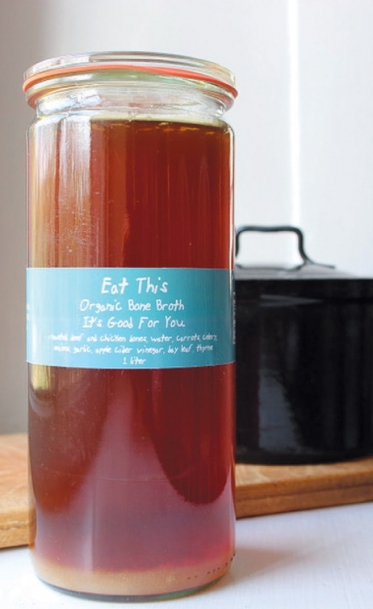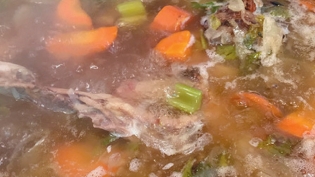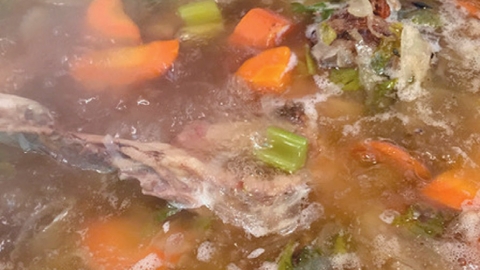Stock Up
Bone broth and its benefits
“Your body uses amino acids as building blocks for all the functions that it needs protein for . . . like skin integrity, bone formation, joint health, wound healing and muscle repair and maintenance.”
—Rosemary Logue, RD, MS
Hunterdon Healthcare’s Center for Advanced Weight Loss, Clinton
Bone broth is not something new. It has been the base of soups for centuries. However, with the rising popularity of superfoods and the recent boon of the Paleo diet, this nutritious broth has experienced a bit of a revival.
It’s worth noting that bone broth is not necessarily a broth or a stock—it’s in a category altogether on its own.
“A broth is usually made with meat [or vegetables], contains a very small amount of bones and gets simmered for a short amount of time,” says Meredith Yorkin, RDN of University Hospital in Newark. “Broth tends to be lighter in flavor, and thinner in texture.”
Yorkin explains that a stock gets simmered longer, about three to four hours, in which case it becomes thicker and a little more viscous because the ingredients get more concentrated. Bone broth, however, is a bit different.
“With bone broth, the bones are roasted first, then simmered in water anywhere from eight to 24 hours or more. At that point, it thickens because lots of gelatin and minerals from the bones are released.”
While bone broth is touted as a nourishing elixir, it can be hard to nail down specific nutritional properties.
“The nutritional composition of bone broth varies because there are so many variations,” says Yorkin. “One would think that since our bones are made up of 50% to 70% minerals—a lot being calcium—then bone broth would be that high in calcium as well, but if you look on a package of bone broth, calcium may be fairly low, or not even be listed,” she says.
Potassium, however, is a mineral that’s often found in bone broth, but again, the amount can fluctuate depending on the recipe.
“Potassium is a mineral and electrolyte that is prevalent in the food we eat, which is a good thing because it’s an important nutrient to help our nerves function and muscles contract,” she says. “Specifically, it helps keep our heartbeat on a regular rhythm and offsets sodium’s harmful effects on our blood pressure.”
Yorkin advises adding leafy greens like kale or collards to your bone broth as a way to boost calcium and potassium, since they contain significant amounts of each.
One nutrient that bone broth does provide in abundance is protein—about 12 grams per cup.
“Bone broth contains protein in the form of collagen,” says Rosemary Logue, RD, MS of Hunterdon Healthcare’s Center for Advanced Weight Loss in Clinton. “Collagen, however, is not a complete protein because it only contains some of the essential amino acids,” she says. “It’s not the same as eating a piece of chicken or an egg, which are complete proteins because they contain all the essential amino acids.”
Logue explains that amino acids of any kind are important to one’s health.
“Your body uses amino acids as building blocks for all the functions that it needs protein for . . . like skin integrity, bone formation, joint health, wound healing and muscle repair and maintenance,” she says.

Three particular amino acids found in collagen have been specifically linked to supporting gut health.
“Glycine, glutamine and proline have been attributed to gut health because they reduce intestinal inflammation,” she says. “They have also been shown to alleviate some of the symptoms of Leaky Gut Syndrome, which is when things leave the gut that aren’t supposed to, and these amino acids help repair it that so it maintains its integrity.”
Logue adds that bone broth isn’t going to be a cure-all and needs to be combined with a healthy, balanced diet.
“Everyone has different amounts of natural collagen, and it tends to diminish as you age. Bone broth can help replenish your body with additional collagen.”
For those who want to make their own bone broth, it’s important to seek out bones from credible sources raising healthy, disease-free animals.
“Over the years, there has been an increase in people purchasing our bones to make bone broth,” says Lucia Stout Huebner of Beechtree Farm, a grass-fed beef farm in Hopewell.
“Bone broth is versatile and economical. Bones are much less expensive than meat, and they can be reused over again,” she says. “It’s also a great way to use the whole animal.”
Huebner adds lemon juice, apple cider vinegar, or wine when cooking the broth because acid helps extract the minerals and nutrients from the bones. She then lets it simmer for 24 to 48 hours.
“It takes time—but it produces a wonderful aroma when you smell it cooking,” she says. “It’s a loving thing to walk into a house and have it smell like dinner.
—Rosemary Logue, RD, MS
Hunterdon Healthcare’s Center for Advanced Weight Loss, Clinton







